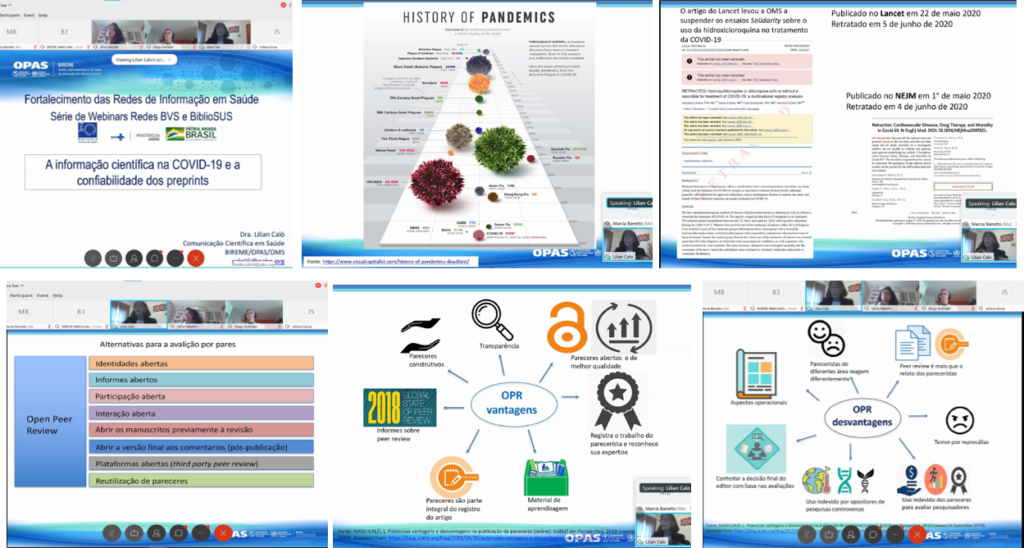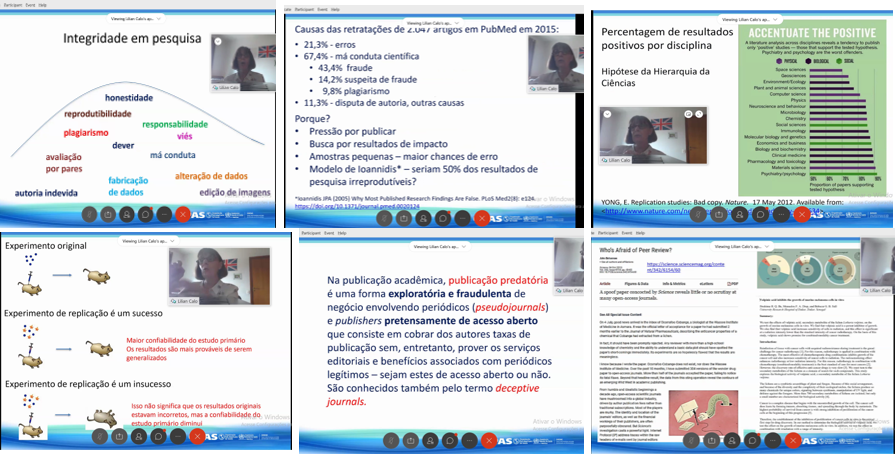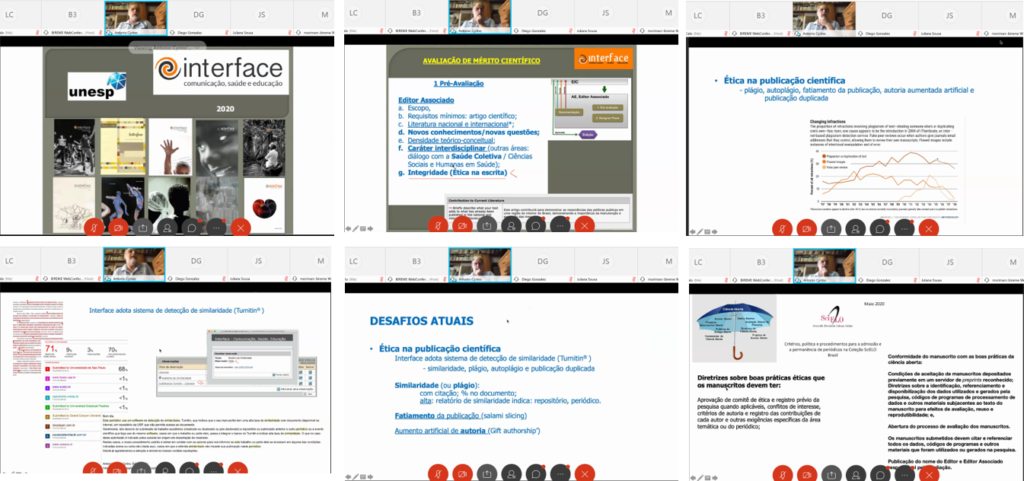The series of six webinars coordinated by the Pan American Health Organization/World Health Organization (PAHO/WHO) through its Representation in Brazil (PAHO Brazil), and the General Coordination of Documentation and Information, Secretary of Administrative Affairs the Executive Secretary of the Ministry of Health (CGDI/SAA/SE/MS) and the Latin American and Caribbean Center on Health Science Information (BIREME), aims at strengthening health information networks, articulate and promote cooperation and participation of the networks of the Virtual Health Library (VHL) and Libraries of the Unified Health System (BiblioSUS).
The first three webinars dealt with topics on the nature of Brazilian Network and its other components, the importance of bibliographic control and the role of as a disseminator and intermediary of health scientific knowledge. Two of the three webinars that complete the series have already occurred, which dealt with scholarly communication topics in the context of the VHL information sources.
The fourth webinar, entitled “Scientific information on COVID-19: the role of preprints”, brought two speakers and more than 100 participants. Lilian Calò (Coordinator of Scholarly Communication in Health at BIREME) analyzed the reliability of preprints in the flow of scientific information in the COVID-19 pandemic. Renato Murasaki (Manager of Information Methodologies and Technologies at BIREME), spoke about the integration of the preprint repositories in the VHL.
In her analysis, Lilian Calò showed the conceptual differences between journal articles and preprints, and how both forms of publication can contribute to the dissemination of research results. Preprints, which are published quickly, but are not subject to pre-publication peer review, but have been screened by the editor of the preprint platform, and scientific articles, which take time to be published, but go through evaluation before publication. In fact, the majority of preprints (67% in the case of bioRxiv) are published in journals up to the years after being posted. Also, any person can make comments (which are moderated), which works as open peer review and is not limited to the reviewers invited by the editor. The author can respond to comments and this dialogue, open to all, is published on the preprint platform. The authors may use those comments to improve his article, as they did in formal peer review.
 Preprints had a major role in the media when it came to reporting on treatments and procedures about COVID-19, as highlighted by Nicholas Fraser[1]: “The fact that media outlets are reporting news extensively from COVID-19 preprints represents a change marked in journalism practice: pre-pandemic bioRxiv preprints received a lot of coverage in comparison to journal articles. This cultural change offers an unprecedented opportunity to create a bridge between the scientific and journalistic communities to create a consensus on how to inform scientific news using preprints, in addition to journal articles.”
Preprints had a major role in the media when it came to reporting on treatments and procedures about COVID-19, as highlighted by Nicholas Fraser[1]: “The fact that media outlets are reporting news extensively from COVID-19 preprints represents a change marked in journalism practice: pre-pandemic bioRxiv preprints received a lot of coverage in comparison to journal articles. This cultural change offers an unprecedented opportunity to create a bridge between the scientific and journalistic communities to create a consensus on how to inform scientific news using preprints, in addition to journal articles.”
Considering the growing relevance of preprints as a source of scientific and technical information in health, Renato Murasaki and his team sought interoperability mechanisms to integrate preprints into the information sources of the VHL, so that they could use the precedence of discoveries, reduce the time of publication and consequently access preprints as quickly as they are available on the servers. For now, due to standards on open platforms, SciELO Preprints on life sciences and the entire collection available in the ARCA Fiocruz repository could be included as sources of information in the VHL. Murasaki also informed that his team is in the final stage of being able to integrate the 8,155 SARS-CoV-2 and COVID-19 preprints available in the bioRxiv and medRxiv repositories (both are initiatives of the Cold Spring Harbor Laboratory, BMJ and the Yale University) in the VHL. The repository metadata is available through a single Application Programming Interface, which is viable for extraction, in addition to using an open data standard. However, the integration of other preprints, for technical reasons, has not yet been possible, but is being analyzed.
 The fifth webinar was on the theme: Ethics in scientific publishing and was presented by Lilian Calò and Antonio Python Cyrino (Editor in Chief of the journal Interface – Comunicação, Saúde, Educação and Professor at the São Paulo State University Julio de Mesquita Filho), with more than 90 participants.
The fifth webinar was on the theme: Ethics in scientific publishing and was presented by Lilian Calò and Antonio Python Cyrino (Editor in Chief of the journal Interface – Comunicação, Saúde, Educação and Professor at the São Paulo State University Julio de Mesquita Filho), with more than 90 participants.
In her speech, Lilian Calò presented the ethics codes in research and publishing, showing what constitutes distortions in research, talked about plagiarism, manipulation of data and images, retraction, reproducibility, predatory publication and how the academy and funding agencies can work with researchers to improve the research ethics.
 Cyrino spoke about plagiarism from the point of view of a scientific editor, the electronic mechanisms he uses to detect similarities in the articles submitted, which are not always intentional. The second most common ethical infraction in his journal is “salami slicing” the partitioning of a substantial article into smaller articles to increase the number of publications, and gifted authorship, characterized when including an author that did not participate in the investigation and/or the writing of the article, but for reasons of prestige the hierarchy is included as an author in the publication.
Cyrino spoke about plagiarism from the point of view of a scientific editor, the electronic mechanisms he uses to detect similarities in the articles submitted, which are not always intentional. The second most common ethical infraction in his journal is “salami slicing” the partitioning of a substantial article into smaller articles to increase the number of publications, and gifted authorship, characterized when including an author that did not participate in the investigation and/or the writing of the article, but for reasons of prestige the hierarchy is included as an author in the publication.
 In his concluding remarks, Cyrino highlighted the sensitive role of journal editor when receiving a manuscript to evaluate its scientific contribution and selecting the proper referees to assess it and follow the entire editorial process. He also mentioned the importance of open science in all steps of the scientific publication process, and that it is in line with what Lilian Calò mentioned in her presentation, that more reproducible, reliable and available science goes necessarily through open science.
In his concluding remarks, Cyrino highlighted the sensitive role of journal editor when receiving a manuscript to evaluate its scientific contribution and selecting the proper referees to assess it and follow the entire editorial process. He also mentioned the importance of open science in all steps of the scientific publication process, and that it is in line with what Lilian Calò mentioned in her presentation, that more reproducible, reliable and available science goes necessarily through open science.
Links of interest
Webinar 4 “Informação científica sobre COVID-19: o papel dos preprints”. Recording and presentations. Available from: http://red.bvsalud.org/2020/08/31/webinar-4-informacao-cientifica-sobre-covid-19-o-papel-dos-preprints/
Webinar 5: “Ética na publicação científica”. Recording and presentations. Available from: http://red.bvsalud.org/2020/09/14/webinar-5-etica-na-publicacao-cientifica/
[1] Fonte: Fraser, N. et al. 2020. Preprinting a pandemic: the role of preprints in the COVID-19 pandemic. bioRxiv. https://doi.org/10.1101/2020.05.22.111294